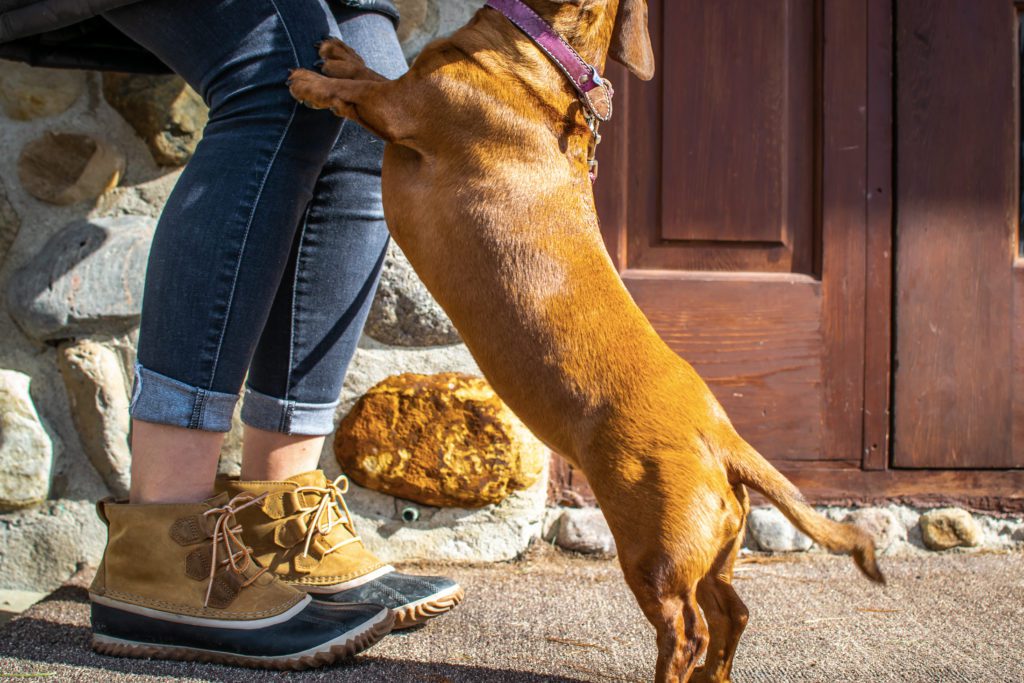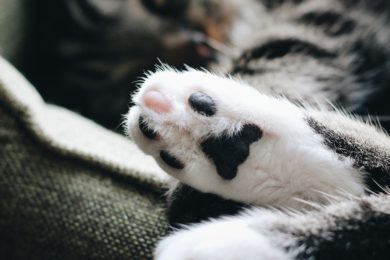
Dominance. Control. Aggression. Is this why your dog jumps up on you? Is he trying to become the “leader of the pack”? No! There’s a simpler – friendlier – explanation. Dogs greet other dogs by sniffing their faces. So, even though you’re a funny-looking two-legged dog with hardly any fur, he wants to do the same to you. While intentions may be good, two paws on your chest or shoulders (especially if they’re muddy!) can be a big nuisance. How do you get your dog to stop jumping?
Do I Have Your Attention?
If your dog is like most, he craves your attention – and your affection. He wants to be pet, stroked, and praised. And what better way to get it than to jump on you! Because he wants that attention so much, withholding it is the key to stopping the undesirable behaviour.
Say you walk into your home, greeted enthusiastically by a jumping pooch. Simply stand still and look ahead. Don’t make eye contact with your dog and do not touch him. Just wait. If you need to, you can bring your hands up to your chest, but other than that, imitate a statue!
When your dog is back on all-fours, pet and praise him. If he continues to jump, turn your back on him. To follow you, he’ll have to put all of his paws on the floor. As soon as he does, show him some puppy love!
There are a few variations on this method that can be helpful if your dog knows the “sit” command.
- If your dog continues to jump, firmly say, “Off.” Turn around and say, “Sit.” When you can see him sit out of the corner of your eye, turn back around and pet him.
OR:
- When your dog jumps, stand still and say “Off.” Take a few quick, small steps towards him so he naturally jumps down to get out of your way. Again, when his feet are back on the ground, praise him like the good dog he is!
This teaches your dog that four feet on the floor = praise and petting. Now, it’s not a lesson he’ll learn immediately, and you will have to repeat this process (sometimes several times in a single greeting!) until he is able to “say hi” appropriately.
Remember: do not withhold attention or affection when your dog’s paws are back on the ground. Petting and praise reinforce your lesson; he learns to curb the undesirable behaviour if he wants the rewards. And he really, really wants the rewards!
Some additional tips to help stop jumping:
- Be consistent! If you allow your dog to jump sometimes, he is getting mixed messages. It’s ok sometimes? But other times I get yelled at? I’ll try it and see what happens! To get the lesson to stick, repeat the process above and don’t give up. Soon, your dog will learn that the secret to those rewards is not jumping.
- Get everyone on board. Again, consistency is key. If you’re the only one teaching your dog not to jump, he’s going to re-learn bad habits from others. Explain the process and importance of withholding attention until all paws are on the floor, and get your friends and family in on the training. Everyone wins!
- Squeaky toys to the rescue. If your dog is particularly excitable, keep squeaky toys by the door. When you come in, toss him a toy to redirect his attention. This is a good strategy when visitors come as well. Another option is to toss a treat 6 to 10 feet from visitors. Doing so teaches your dog to stay away from – and off of – people.
- Be calm. Your dog plays off of your energy. If you come in excited, he’ll be doubly excited. So stay calm! Speak in soothing tones and use a gentle touch.
Teaching your dog not to jump is easy – in theory! In practice, it can be difficult to stick with, especially when it seems like he does it every single time he sees you! Keep at it: your reward is a dog that’s happy to see his funny-looking, two-legged friend but knows to keep all four paws on the ground.


